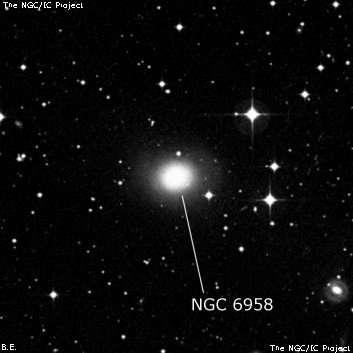
John Herschel discovered NGC 6958 = h3841 on 24 Aug 1834 and recorded "B; R; pgmbM: 25"; follows 4 stars; of which one is 9m." His position is accurate. Using his 5-inch refractor at Vanderbilt, Barnard described NGC 6958 as "close following three or four small bright stars. The light from these stars makes it difficult to see the nebula, which small pretty suddenly much brighter in the middle to a flickering, ill-defined nucleus. I can not see why it should be called bright in G.C., probably in the southern hemisphere it is much brighter."
200/250mm - 8" (7/24/82): faint, small, round, just nonstellar at low power. Located at the edge of a small "V" asterism of stars. Located 25' WSW of a mag 5.5 star. Pretty low elevation from Northern California.
400/500mm - 17.5" (10/5/91): fairly faint, fairly small, gradually increases to a very small bright core. Forms the SE vertex of an equilateral triangle with a mag 11 star 2.5' WSW and a mag 10 star 2.8' NW. There are four stars total in this V-shaped asterism.
600/800mm - 24" (9/8/18): at 260x; fairly bright, fairly small, round, sharp strong concentration with a very bright, 0.6' core that gradually increases towards the center. With careful viewing the core is surrounded by a very low surface brightness halo with no distinct edge, but perhaps 1.0' diameter. Just east of a group of four stars including a mag 9.5 star 2.8' NW.
NGC 6958 is projected (in the foreground) near the center of ACO S900. ESO 341-013, the brightest cluster member, lies 19' WSW. It appeared fairly faint, fairly small, slightly elongated, ~30"x25", brighter core.
Notes by Steve Gottlieb